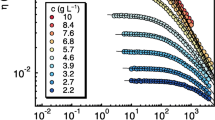Abstract
Using a controlled-temperature shear cell mounted on a polarizing microscope, we observe the behavior of nematic 4,4′-n-octyl-cyanobiphenyl (8CB) during start-up and reversal of shearing in a torsional parallel-plate geometry and correlate this behavior with rheological measurements. During the start-up, a sequence of birefringent rings, or “twist walls”, are observed that originate at the sample edge and propagate radially inward. Each twist wall is a thin region in which the director is twisted out of the plane of the velocity and velocity-gradient directions. The radial variation of in-plane orientation can be explained by the variation of strain in the parallel-plate device. A high Ericksen-number solution of the Leslie-Ericksen equations predicts a damped oscillatory shear stress response which agrees quantitatively with the measured stress oscillations out to an edge strain of around 50. The damping of the stress oscillations is due to the nonuniformity of strain in the parallel-plate geometry. On reversal of the flow, if the strain, γ, is smaller than about 500 units, the damping of stress oscillations is reversed; this correlates with an outward radial migration of twist walls. When γ > 500, disclinations nucleate and spoil the reversibility of stress damping.
Similar content being viewed by others
References
Bloss FD (1961) An introduction to the methods of optical crystallography. Holt, Rinehart and Winston, New York
Burghardt WR, Fuller GG (1990) Transient shear flow of nematic liquid crystals: manifestations of director tumbling. J Rheol 34:959
Carlsson T (1984) Theoretical investigation of the shear flow of nematic liquid crystals with the Leslie viscosity α3>0: Hydrodynamic analogue of first order phase transitions. Mol Cryst Liq Cryst 104:307
Carlsson T, Skarp K (1986) Observation of the tumbling instability in torsional shear flow of a nematic liquid crystal with α3>0. Liq Cryst 1:455
Gu D-F, Jamieson AM, Wang S-Q (1993) Rheological characterization of director tumbling induced in a flow-aligning nematic solvent by dissolution of a sidechain liquid crystal polymer. J Rheol 37:985
Gu D-F, Jamieson AM (1994) Rheological characterization of director dynamics in a nematic monodomain containing mesogenic polymers of differing architectures. Macromolecules 27:337
Han WE, Rey A (1995) Simulation and validation of temperature effects on the nematorheology of aligning and nonaligning liquid crystals. J Rheol 39:301
Manneville P (1981) The transition to turbulence in nematic liquid crystals. Mol Cryst Liq Cryst 70:223
Mather PT (1994) Shear flow behavior of tumbling and flow-aligning nematic liquid crystals. PhD thesis, U.C. Santa Barbara
Mather PT, Pearson DS, Burghardt WR (1996a) Structural response of nematic liquid crystals to weak transient shear flows. J Rheol 39:627
Mather PT, Pearson DS, Larson RG (1996b) Flow patterns and disclination density measurements in sheared nematic liquid crystals. I. Flow-aligning 5 CB. Liq Cryst 20:527
Mather PT, Pearson DS, Larson RG (1996c) Flow patterns and disclination density measurements in sheared nematic liquid crystals. II. Tumbling S CB. Liq Cryst 20:539
Pikin SA (1974) Couette flow of a nematic liquid. Soviet Phys JETP 38:1246
Rey A (1993) Stationary bifurcations and tricriticallity in a creeping nematic polymer flow. J Non-Newt Fluid Mech 50:1
Skarp K, Carlsson T, Lagerwall ST, Stebler B (1981) Flow properties of nematic 8CB: an example of diverging and vanishing α3. Mol Cryst Liq Cryst 66:199
Author information
Authors and Affiliations
Corresponding author
Additional information
Deceased
Rights and permissions
About this article
Cite this article
Mather, P.T., Pearson, D.S., Larson, R.G. et al. The origin of stress-oscillation damping during startup and reversal of torsional shearing of nematics. Rheol Acta 36, 485–497 (1997). https://doi.org/10.1007/BF00368126
Received:
Accepted:
Issue Date:
DOI: https://doi.org/10.1007/BF00368126




